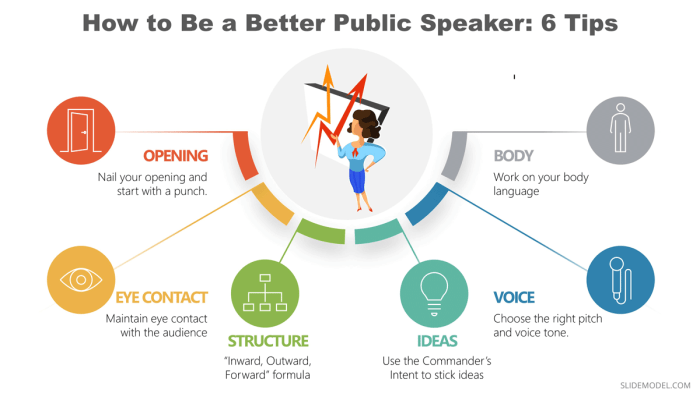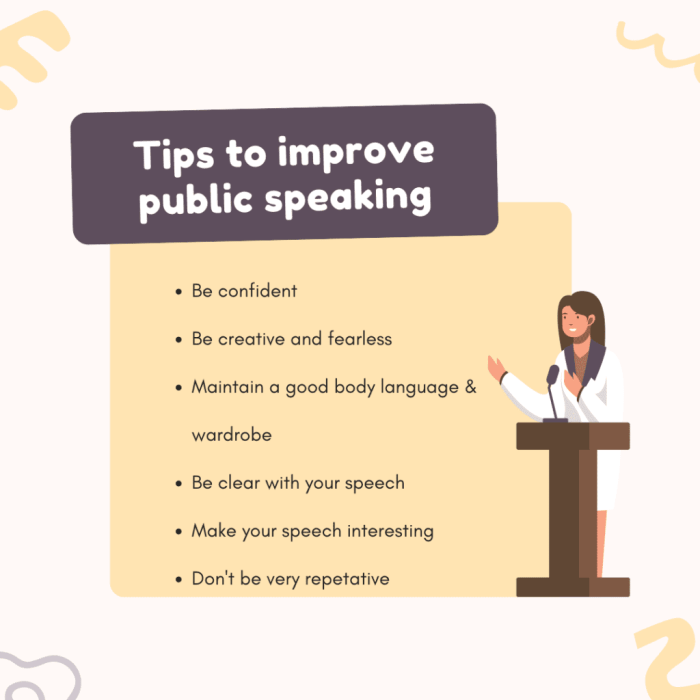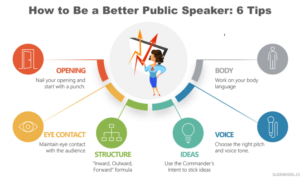Public Speaking Tips: Whether you’re a seasoned pro or a nervous beginner, mastering the art of captivating an audience is crucial in various aspects of life. From overcoming anxiety to nailing your delivery, this guide has got you covered.
Ready to take your public speaking game to the next level? Let’s dive in!
Importance of Public Speaking
Public speaking is a valuable skill that can have a significant impact on personal and professional growth. It allows individuals to effectively communicate their ideas, persuade others, and build strong relationships.
Enhanced Communication
- Public speaking helps individuals articulate their thoughts clearly and concisely, improving overall communication skills.
- It enables individuals to engage with diverse audiences, fostering better understanding and connection.
- Effective communication through public speaking can lead to successful collaborations and partnerships.
Career Advancement
- Professionals with strong public speaking skills are often viewed as confident and competent leaders in their fields.
- Public speaking can open doors to new opportunities, such as presenting at conferences, leading meetings, or pitching ideas to potential investors.
- Individuals who excel in public speaking are more likely to advance in their careers and secure higher positions.
Personal Growth
- Overcoming the fear of public speaking can boost self-confidence and self-esteem.
- Public speaking allows individuals to share their unique perspectives and showcase their expertise, leading to personal fulfillment.
- Developing public speaking skills can empower individuals to advocate for themselves and others, driving positive change in their communities.
Overcoming Public Speaking Anxiety
When it comes to public speaking, anxiety can hit hard. The fear of messing up, being judged, or forgetting what to say can be overwhelming. But fear not, there are ways to conquer this anxiety and become a confident speaker.
Common Reasons for Public Speaking Anxiety
- Feeling unprepared or underqualified
- Worrying about making mistakes or forgetting what to say
- Fear of being judged by the audience
- Pressure to perform perfectly
Strategies for Managing and Reducing Anxiety
- Practice, practice, practice – Rehearse your speech multiple times to build confidence
- Breathing techniques – Deep breathing can help calm nerves before speaking
- Visualize success – Imagine yourself delivering a successful speech to boost confidence
- Focus on the message, not yourself – Shift the focus from your fears to the content you are delivering
Tips on Building Confidence in Public Speaking
- Start small – Begin by speaking in front of a mirror or a small group of friends
- Seek feedback – Constructive criticism can help you improve and boost your confidence
- Avoid perfectionism – Embrace imperfections and learn from mistakes
- Affirmations – Use positive affirmations to boost your self-confidence before speaking
Preparation Techniques

When it comes to giving a successful speech, preparation is key. By following the right steps and knowing your audience, you can structure a compelling speech that will leave a lasting impact.
Steps for Effective Speech Preparation
- Research your topic thoroughly to gather relevant information and data.
- Organize your thoughts and main points in a logical order for easy understanding.
- Practice your speech multiple times to ensure fluency and confidence.
- Prepare visual aids or props to enhance your presentation if needed.
- Rehearse in front of a trusted friend or family member to receive feedback and make necessary adjustments.
Knowing the Audience Before Giving a Speech
Understanding your audience is crucial for tailoring your speech to their needs and interests. By knowing their demographics, preferences, and expectations, you can adjust your content and delivery style to resonate with them effectively.
Tips for Structuring a Compelling Speech, Public Speaking Tips
- Start with a captivating introduction to grab the audience’s attention from the beginning.
- Clearly Artikel your main points and transitions to guide the audience through your speech smoothly.
- Incorporate stories, anecdotes, or examples to make your content relatable and engaging.
- Use visual aids sparingly to support your points without overwhelming the audience.
- Conclude with a strong and memorable ending that reinforces your key message and leaves a lasting impression.
Delivery Tips
When it comes to public speaking, how you deliver your message is just as important as what you say. Your body language, vocal delivery, and ability to engage the audience can make or break your presentation. Here are some tips to help you improve your delivery and captivate your audience.
Significance of Body Language
Body language plays a crucial role in public speaking as it can convey confidence, credibility, and authenticity. Here are some techniques to help you make the most of your body language:
- Stand tall and maintain good posture to project confidence and authority.
- Make eye contact with your audience to establish a connection and show sincerity.
- Use hand gestures purposefully to emphasize key points and add dynamism to your speech.
- Move around the stage or speaking area to keep the audience engaged and maintain their interest.
Improving Vocal Delivery
Your vocal delivery can greatly impact how your message is received. Here are some techniques to enhance your vocal delivery during a speech:
- Speak clearly and enunciate your words to ensure your message is understood.
- Vary your pitch, tone, and volume to keep the audience engaged and prevent monotony.
- Pace your speech appropriately, allowing for pauses to emphasize important points and give the audience time to digest information.
- Practice proper breathing techniques to control your voice and maintain a steady pace throughout your speech.
Engaging the Audience
Keeping your audience engaged is essential to a successful speech. Here are some tips to help you connect with your audience and maintain their interest:
- Start with a compelling opening to grab the audience’s attention from the start.
- Use storytelling, humor, or personal anecdotes to make your speech relatable and memorable.
- Ask questions or encourage audience participation to create a dialogue and keep them involved.
- Use visual aids or props strategically to enhance your message and provide visual interest.
Handling Q&A Sessions: Public Speaking Tips

When it comes to handling Q&A sessions after your presentation, it’s essential to be prepared for any questions that may come your way. This is an opportunity to engage with your audience, clarify any points, and showcase your expertise. Here are some strategies to help you navigate Q&A sessions confidently.
Strategies for Handling Questions
- Calm Confidence: Maintain a calm and confident demeanor when answering questions, even if you’re unsure of the answer. Take a moment to gather your thoughts before responding.
- Active Listening: Pay close attention to the question being asked. Ensure you understand it fully before providing a response. Paraphrasing the question can help clarify any misunderstandings.
- Stay on Topic: Keep your responses relevant to the topic of your presentation. If a question veers off track, politely guide it back to the main subject.
Responding to Challenging Questions
- Stay Composed: Remain composed and composed when faced with challenging or unexpected questions. Take a deep breath and consider your response carefully.
- Honesty is Key: If you don’t know the answer to a question, it’s okay to admit it. Offer to follow up with more information after the session.
- Bridge Responses: Use bridging phrases like “That’s an interesting point, and I’d like to address it by…” to transition smoothly from challenging questions to your response.
Transitioning to Q&A Session
- Signal the Shift: Clearly signal the transition from your presentation to the Q&A session. You can say something like, “Now, I’d like to open the floor for questions.”
- Encourage Participation: Encourage audience participation by welcoming questions and creating a safe space for open dialogue.
- Set Time Limits: Establish time limits for the Q&A session to ensure that you address as many questions as possible within the allocated time frame.
